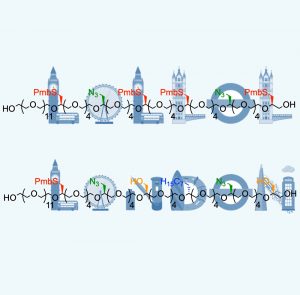Researchers in the Livingston Group at Imperial College London have developed a new class of multi-functional sequence-defined polyether that shows potential across a broad range of applications from drug delivery, to nanotechnology and information storage.
Published today in Nature Chemistry these sequence-defined polymers are the first of their kind to be reported, and have been created by coupling a novel liquid-phase iterative synthesis to size-exclusion membrane nanofiltration technology, producing a monodisperse polyether with over 98% chain purity, much higher than conventional synthetic polymers.
Chemists have devoted substantial research to developing precision synthetic polymers with defined monomer sequences and specific functions because of their similarity to sequences found in nature. Natural macromolecules, such as nucleic acids and proteins, contain a perfectly defined chain length and monomer sequence which provides them with the structural and functional diversity to meet the needs of living organisms.
Polyethers, in particular uniform poly(ethylene glycol)s (PEGs) with exactly defined chain lengths, are favoured for use in the human body because of their excellent water solubility, non-immunogenicity and biocompatibility, making them perfect for use in biomedical and pharmaceutical fields. However, it has not been possible to produce precision polymers with these properties with conventional solid-phase iterative synthesis using insoluble solid supports owing to harsh Williamson ether synthesis.

‘LOLLOL’ and ‘LONDON
Using polymer membranes with a nanoscale pore size, researchers in the Livingston Group created a uniform sequence structure with readily tailored side-chain functionalities by diafiltering out excess monomers and other reaction debris while retaining the bulkier growing polymer. This process uses unique real-time monitoring to ensure reaction completion and a three-armed star molecule as a soluble support to triple the size of growing polymer. The bulky three-armed hub molecule provides good combination of molecular bulk and steric accessibility, functioning as both a protecting group for one end of the polyether and as label for monitoring reactions because of its high UV extinction coefficient.
Remarkably, the monomer sequence is precisely controllable, offering the potential for site-selective multi-functionalisation, through the incorporation of functional elements at specific side-chain sites, such as affinity agents, imaging agents, anticancer drugs, genes, proteins, or pharmacokinetic modifiers, to generate a multifunctional macromolecular medicine. The polymer can also be used in information storage – the four monomers are coded as L, O, N, D and polymers “spelling” LONDON and LOLLOL have been using this PEG alphabet, or PEGabet. The researcher from Swansea University involved in this project has further determined the exact sequence of these polymers using tandem mass spectrometry. This kind of sequence defined polymers has great potential and has been designed in a way which allows for easy up-scaling in production.
Dr Ruijiao Dong, lead researcher on the project, said: “It’s an exciting piece of research to lead because we’re one step closer to creating a well-defined hierarchical structure which mimics that found in nature. By developing a universal strategy for controlling the monomer sequence in synthetic polymers we’re in theory able to make any polymeric materials with precisely controlled functions, as the sequence plays a crucial role in information storage and function expression, offering great potential for widespread applications ranging from nanotechnology, information storage to healthcare. It will be interesting to explore the potential and test the limits of its functionality for further research.”
The team will now be exploring the practical applications of this new polyether and experimenting with producing a biodegradable version of sequence defined polymers.
Read the paper in full at Nature Chemistry.